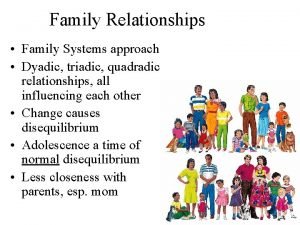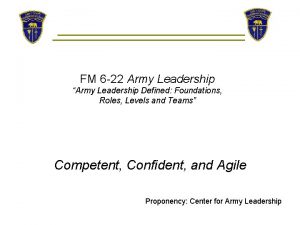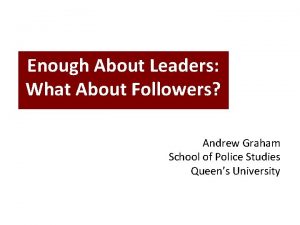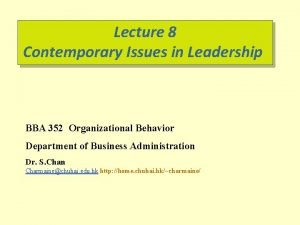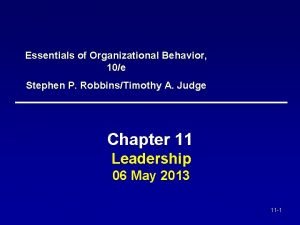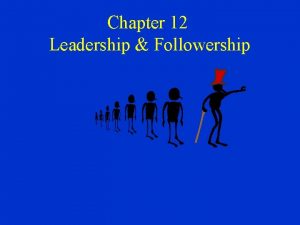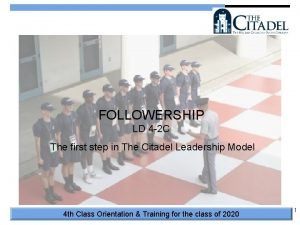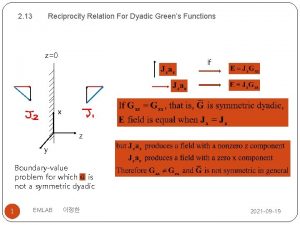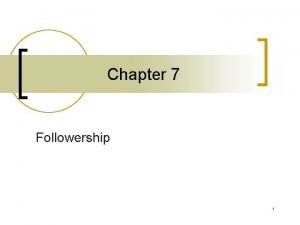CHAPTER 5 DYADIC RELATION AND FOLLOWERS Followership Everyone

































- Slides: 33

CHAPTER 5 DYADIC RELATION AND FOLLOWERS

Followership • Everyone is follower/leader at some point of his life. • Position that play a followership, then the situation demand to be a leader. • Followers who are perceived to be the most effective are most likely to be asked to take lead when opportunities arise. • Vital role of followers play in societal change and organizational performance-follower as asset/engage/happier/increase performance.

• Why do you want to be a follower?

The goal of followership • The goal of followership might be different from the organization. • Even though mission/vision is shared in the organization • Follower might leave the organization if they find it the organization does not fit their personal goal. • Follower wants to secure the job, while organization wants to maximize financial performance-

DYADIC RELATION • Vertical Dyadic Model • Leader Member Exchange • Practicing Theory Y

Vertical Dyad Linkage (VDL) Model • Argues for the importance of the dyad formed by a leader with each member of the group • In-group relationship - Seen among members with whom leaders spend a disproportionate amount of time • Out-group relationship - Seen among members of the group who did not experience a sense of trust and extra consideration 6

Exhibit 2. 7 - Leader Behavior Toward In-Group versus Out-Group Members Sources: Based on Jean François Manzoni and Jean-Louis Barsoux, “The Set-Up-to-Fail Syndrome, ” Harvard Business Review (March–April 1988), pp. 110– 113; and Mark O’Donnell, Gary Yukl, and Thomas Taber, “Leader Behavior and LMX: A Constructive Replication, ” Journal of Management Psychology 27, no. 2 (2012), pp. 143– 154. 7

Leader-Member Exchange (LMX) • Explores how leader-member relationships develop over time and how the quality of exchange relationships affects outcomes • high-exchange relationship Subordinate commitment is important when the leader’s work unit has tasks that require considerable initiative and effort on the part of some members to be carried out successfully. • A low-exchange relationship is characterized by less mutual influence 8

Practicing Theory: X and Y 9 Source: J. Hall and S. M. Donnell, “Managerial Achievement: The Personal Side of Behavioral Theory, ” Human Relations 32 (1979), pp. 77– 101

Appropriate ways to manage subordinates-Performance Deficiencies • • • Gather performance information Avoid attribution biases Provide corrective feedback Describe deficiency Explain ineffective behavior impact Remain professional 9 -10 Copyright© 2013 Pearson Education Leadership in Organizations

MANAGE IMPRESSION -Social Perception • Making sense out of the environment by selecting, organizing, and interpreting information • Values and attitudes affect perceptions, and vice versa 11

Perpetual Distortions • Projection: Tendency to see one’s own personal traits in others • Perceptual defense: tendency of perceivers to protect themselves against ideas, objects, or people that are threatening to them is called perceptual defence. 12

Attributions • Self-serving bias: Tendency to overestimate the influence of: • Internal factors on one’s successes • External factors on one’s failures 13

Cognitive Differences • Cognitive style: How a person perceives, processes, interprets, and uses information • Patterns of thinking and brain dominance • Left hemisphere - Logical, analytical thinking and a linear approach to problem solving • Right hemisphere - Creative, intuitive, values-based thought processes 14

Cognitive Differences • Whole brain concept: Considers a person’s preference for right-brained versus left-brained thinking and conceptual versus experiential thinking • Identifies four quadrants of the brain related to different thinking styles 15

Exhibit 4. 4 - Hermann’s Whole Brain Model 16 Source: Ned Herrmann, The Whole Brain Business Book (New York: Mc. Graw-Hill, 1996) p. 15

Myers-Briggs Type Indicator (MBTI)™ • Measures how individuals differ in gathering and evaluating information for solving problems and making decisions • Uses different pairs of attributes to classify people in 1 of 16 different personality types • Introversion versus extroversion • Sensing versus intuition • Thinking versus feeling • Judging versus perceiving 17

Working with Different Personality Types • Leaders can work effectively by: • • • Understanding one’s own personality and how they react to others Treating everyone with respect Acknowledging each person’s strengths Striving for understanding Remembering that everyone wants to fit in 18

Effective Leadership Leader & Follower • Follower identities- who have the personality of: • • courageous follower are likely to be more effective Self-confidence Passion for change Strong commitment to the organization and mission Copyright© 2013 Pearson Education Leadership in Organizations 9 -19

Building Effective Relationship with superior Understanding Superior’s world Adapting to superior’s style Help superior organize objective Ignore follow superior’s style-fail to get promoted Loyalty and support Followers need to be flexible Knowing superior’s values, preferences and personality Clarify expectation about your (followers) role Understanding superior limitation (eg; time)keep informed activities Honest and dependable-trustworthy, integrity, do what they promise.

Guideline s for Followers Find out what you are expected to do. Take the initiative to deal with problems. Keep the boss informed about your decisions. Verify the accuracy of information you give the boss. Encourage the boss to provide honest feedback to you.

Support efforts to make necessary changes. Show appreciation and provide recognition when appropriate. Guideline s for Followers Challenge flawed plans and proposals made by bosses. Resist inappropriate influence attempts by the boss. Provide upward coaching and counseling when appropriate. Learn to use self-management strategies: cognitive&behavior

Group Activities • As a leader, what would you want the most from the followers? As a follower, what would you want the most from your leader? How do these differ? Why?

IMPRESSION MANAGEMENT • Exemplification. This tactic involves behavior intended to demonstrate dedication and loyalty to the mission, to the organization, or to followers. Exemplification tactics used to influence bosses include arriving early and staying late to work extra hours, demonstrating effective behavior when you know the person is watching, and doing voluntary tasks that are highly visible (“organizational citizenship behaviors”). Exemplification tactics used to influence subordinates or peers include acting in a way that is consistent with espoused values (“walking the talk”) and making self-sacrifices to achieve a proposed objective, change, or vision.

IMPRESSION MANAGEMENT • Ingratiation. This tactic involves behavior intended to influence the target person to like the agent and perceive the agent as someone who has desirable social qualities (e. g. , friendly, considerate, caring, charming, interesting, attractive). Ingratiating behavior can take many different forms. Some examples include providing praise, agreeing with the target person’s opinions, showing appreciation for the target’s accomplishments, laughing at the target’s jokes, showing an interest in the target’s personal life, and showing deference and respect for the target person.

IMPRESSION MANAGEMENT • Self-Promotion. This tactic involves behavior intended to influence favorable impressions about your competence and value to the organization. The behavior may take the form of informing people about your achievements and talking about your skills. A more subtle form of self-promotion is to display diplomas, awards, and trophies in one’s office or workspace for others to see. An indirect form of self-promotion that is similar to a coalition tactic is to get other people to talk about your skills and loyalty

Followers input are vital for team performance Potter and Rosenbach Followershi p Model Followers are closest to the action and often have the best solutions to problems. This model consist of two dimension • Performance- is concerned with the extent to which an individual follower can do his or her job/ effectively with other members of the team. • Relationship- is concerned with the degree to which followers act to improve their working relationship with their leader.

Relationship Potter and Rosenbach Followership Model

The Curphy Roellig Followership Model • Two dimension and 4 followership types • Dimension: Critical thinking-followers ability to challenge the status quo • Dimension: Engagement-level of effort people put at work • Four followership types are criticizers, slackers, self-starters and brown-nosers

Curphy and Roellig Followers hip Model Critical thinking • The

The Curphy and Roellig Followership Model • This model helps the leaders assess followership types and determine the best way to motivate. • Followership types are not static, change depending on the situation. • The Curphy and Roellig Followership Model Journey line-Brown noser-self-starter, criticizers, slackers

GROUP ACTIVITIES • Is it possible to develop different dyadic relationships and still treat everyone fairly?

THE END
 Dyadic relationship adalah
Dyadic relationship adalah Hope youre doing well
Hope youre doing well Peirce semiotics
Peirce semiotics Childless family adalah
Childless family adalah Scala das
Scala das Dyadic green's function
Dyadic green's function Definisi keluarga
Definisi keluarga Psychotraumatherapeut
Psychotraumatherapeut Dyadic resourcing
Dyadic resourcing Curphy and roellig followership model
Curphy and roellig followership model Followership and servant leadership
Followership and servant leadership Follower readiness
Follower readiness Servant leadership vs followership venn diagram
Servant leadership vs followership venn diagram Alienated followers
Alienated followers Army leadership requirements model
Army leadership requirements model 5 dimensions of courageous followership
5 dimensions of courageous followership Servant leadership vs followership army venn diagram
Servant leadership vs followership army venn diagram Pragmatic follower
Pragmatic follower Dynamic followership
Dynamic followership Why does the visitor frighten the guests
Why does the visitor frighten the guests House path goal theory
House path goal theory Contemporary leadership roles
Contemporary leadership roles Inspirational approaches to leadership
Inspirational approaches to leadership How do charismatic leaders influence followers
How do charismatic leaders influence followers Be ye followers of god
Be ye followers of god Number of buddhism followers
Number of buddhism followers What ideas of jesus attracted followers
What ideas of jesus attracted followers Trickle down theory in fashion
Trickle down theory in fashion Followers of islam
Followers of islam A good leader will have followers who ______.
A good leader will have followers who ______. Victorious politicians rewarding of their followers
Victorious politicians rewarding of their followers World's largest universalizing religion
World's largest universalizing religion Well welcome to the class everybody
Well welcome to the class everybody Cybersecurity and cyberwar what everyone needs to know
Cybersecurity and cyberwar what everyone needs to know








